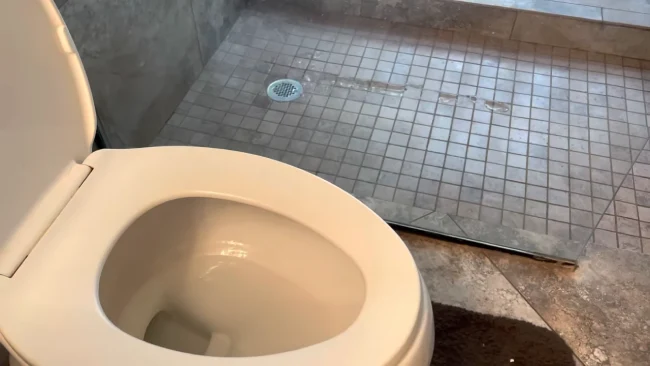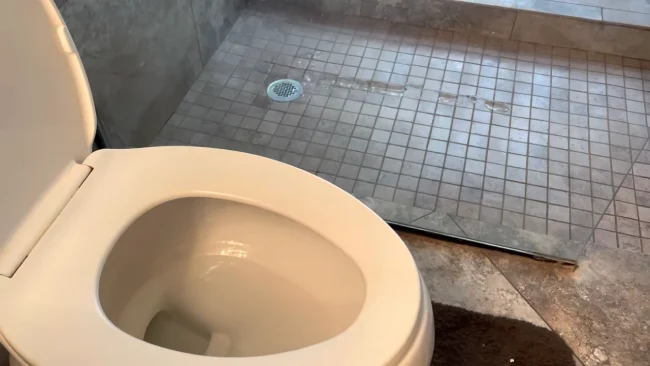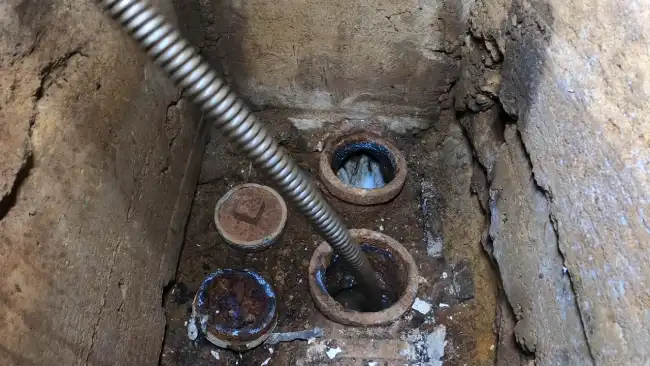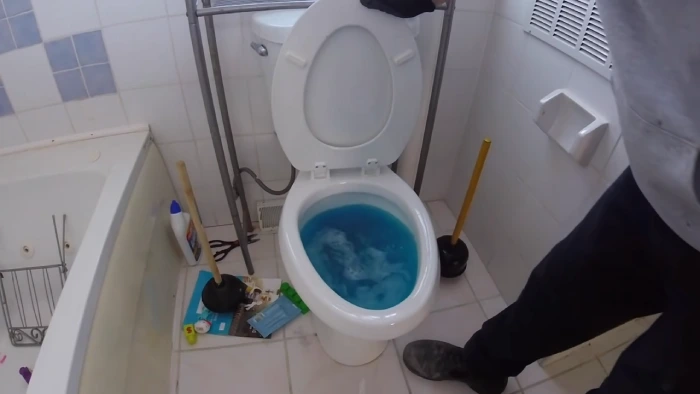Last Updated on November 14, 2023
Toilet overflows are not only unpleasant, but they are also hazardous to your health. Cleaning up after a toilet overflow is labor-intensive, requiring much effort and attention to detail.
Also, a poorly cleaned-up toilet overflow can lead to mold growth, which poses a significant health risk for you and your family. For this reason, you need to know how to clean overflows effectively.
To clean a toilet floor after overflow, shut off the water supply valve first. Afterward, remove the excess water from the floor. After that, unclog the toilet and get rid of any standing water. Next, the floor needs to be cleaned, disinfected, and dried.
We will talk about how to clean a toilet floor after it overflows. We will also discuss some common reasons that can lead to a toilet overflow. Keep reading for more information.
How to Clean Floor After Toilet Overflows Effectively?

Step 1: Shut Off the Water Supply to the Toilet Tank
Step 2: Clean Up Excess Water from the Floor
Step 3. Remove Standing Water from the Toilet Bowl
Step 4. Unclog the Toilet with an Auger or a Drain snake
Step 5. Clean and Disinfect the Floor
Step 6. Dry the Floor after Disinfect
A toilet overflow can be an unfortunate and unpleasant experience for any homeowner. Not only is it unsanitary, but it can also leave behind a mess on your floors. Here are the steps to follow:
Step 1: Shut Off the Water Supply to the Toilet Tank
Turning off the valve that supplies water to the toilet tank is the first step in preventing overflow. The valve is typically located behind or next to the toilet and can be turned off by rotating it clockwise. Doing this will prevent additional water from entering the toilet tank.
Step 2: Clean Up Excess Water from the Floor
Immediately remove excess moisture from the immediate area after a toilet overflows with absorbent materials. To clean up too much water from the toilet floor effectively, follow the steps below:
- Soak up as much water as possible using an old towel or mop.
- Pay attention to every tile on tile floors and get in between each tile with a sponge or cloth.
- Ensure that you dispose of used cleaning materials properly.
Standing water on your floor can cause mold growth and further damage. Therefore, acting fast and removing excess water immediately is essential.
Step 3. Remove Standing Water from the Toilet Bowl
After cleaning excess water from the floor, use a wet/dry vacuum or a Bail Out/Sponge to remove standing water from the toilet bowl. This will prevent additional water from spilling onto the floor and causing more damage.
Step 4. Unclog the Toilet with an Auger or a Drain snake
Using a toilet auger or drain snake is an effective method to remove clogs and restore proper water flow in the toilet. This tool is designed with a long, flexible cable that can be inserted into the toilet drain to break any obstruction.
As the auger is rotated, it hooks onto whatever is causing the blockage, allowing for easy removal. Using an auger or drain snake is often more effective than other methods, like plunging or using chemicals that may damage your pipes.
Step 5. Clean and Disinfect the Floor
Use bleach-based cleaning products while wearing protective gloves to sanitize the affected area effectively. Bleach is a powerful disinfectant that can kill many microorganisms, including bacteria and viruses. But handle bleach with care, as it can cause skin irritation and may release harmful fumes.
Start by cleaning the entire floor, even areas not directly affected by the overflow. Use a mop or a scrub brush to apply the bleach solution to the floor and let it sit for at least 10 minutes before rinsing thoroughly with water. Pay extra attention to corners and crevices where bacteria may accumulate.
Step 6. Dry the Floor after Disinfect
After properly completing the sanitation process, ensure the floor is thoroughly dried after disinfecting it. A wet surface can lead to mold and mildew growth, which can cause respiratory problems and allergic reactions.
Use clean towels or absorbent materials to soak any remaining moisture to dry the floor. If necessary, use fans or dehumidifiers to speed up the drying process. Avoid using heat sources such as heaters or hairdryers since they can damage some flooring materials.
What are the Common Causes of Toilet Overflows?

Toilet overflows can be a frustrating and unpleasant experience for homeowners. There are several common causes of toilet backflows, including:
#1 Clogged Toilet Traps
Accumulating debris in the S-shaped trap can impede proper toilet function and lead to overflow. This can occur when cotton balls, dental floss, facial tissues, or other foreign objects become trapped in the pipe’s curve.
When clogged, water cannot flow freely through the trap and into the drain pipes. This results in a backup that may lead to an overflowing toilet.
#2 Clogged Drain Pipes
Clogged drain pipes can also cause backups in the plumbing system, leading to potential damage and costly repairs. As water and waste materials pass through the pipes, they can get caught in debris or buildup within the pipe walls.
Common culprits of clogs include hair, soap scum, food particles, and even mineral deposits from hard water. When a drain pipe becomes clogged, address it as soon as possible before it causes further issues.
#3 General Fixture Failures
When plumbing fixtures fail, it can be a frustrating and costly experience for homeowners. General fixture failures such as leaks, cracks, or broken handles can cause water damage to floors, walls, and ceilings.
With the inconvenience of not having access to functioning fixtures, owners may have to pay for costly repairs or replacements. This emphasizes the importance of regular maintenance and inspection of plumbing systems.
#4 Clogged Sewer Laterals
Another common cause of toilet overflows is a clogged sewer lateral, the pipe connecting your house to the city main.
If this pipe becomes blocked due to debris buildup or tree roots, it can prevent proper drainage and cause water to back into your home. This can lead to toilet overflows, basement flooding, and drain backups.
Can a toilet overflow cause mold?

Mold growth is a prevalent concern resulting from toilet overflows, with spores potentially developing and spreading rapidly within 24 to 48 hours. Typically, mold is a fungus that thrives in damp environments and can be dangerous when unchecked.
Here are three ways that toilet overflows can cause mold:
- Moisture: The water from an overflowing toilet creates a moist environment where mold spores can thrive. If the moisture is not properly removed, it can lead to the growth of hazardous molds.
- Organic material: When toilets overflow, they often bring organic material such as feces and urine. These materials provide nutrients for mold to grow and multiply.
- Poor ventilation: Bathrooms are usually small spaces with poor ventilation, making it difficult for moisture to evaporate quickly. This creates an ideal environment for mold growth.
Quickly Clean Up Toilet Overflows to Prevent Serious Damage
Toilet overflows can be a nightmare for any homeowner, especially when cleaning up the aftermath. Acting quickly and efficiently is the key to effective cleaning up after an overflow.
Ignoring an overflowing toilet can lead to more serious problems, including mold growth and structural damage. So, address the issue promptly and with diligence.
Following the above-mentioned steps, you can effectively clean up after a toilet overflow and prevent further damage. Overflowing toilets can have severe long-term consequences if left unattended.

